Artillery units of the 101st Airborne Division
My interest
| Aviation Archaeology
| Ramsbury's
Home Front | Ramsbury
Airfield | Savernake
Ammo Dump | Mystery
Corner | 101st
Airborne Division
Membury
airfield | Normandy
- some places of interest |
Links
Page |
Home
Page |
Obituaries
| Recommended
Reading | Aldbourne
Stable Project |
The
Great War
Throughout WWII the 101st Airborne Division Artillery was commanded by Brigadier General Anthony C McAuliffe. During most of his time in England McAuliffe, and the nine members of his staff, were quartered at Wormstall House, which was owned by a Mrs Charrington. Before moving there he had spent a short period at Benham Vallence, a place he described as 'a castle', but it was cold and draughty and he found Mrs Charrington's home much more to his liking. He had as his personal transport a Ford Sedan, which was usually driven by a Sgt. Brown who was also quartered at Wormstall, together with two cooks and two orderlies. Wormstall is located just to the south-east of the village of Wickham about 5 miles west of Newbury.
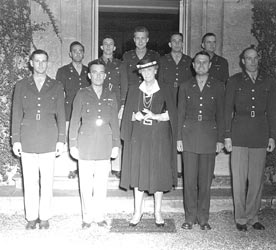
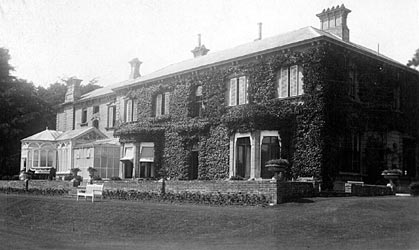
Left:
Mrs Charrington (centre) together with Brig. Gen. McAuliffe (front row second
from left) and his staff at Wormstall. Right: A wartime picture
of Wormstall House.
(Both pictures via Kenneth McAuliffe)
The 101st
Airborne Artillery was made up of the following units: 81st Airborne Anti-aircraft
Artillery (AAA), 321st Glider Field Artillery (GFA),
377th Parachute Field Artillery (PFA) and the 907th Glider Field Artillery
(GFA).
81st AAA Battalion
The 81st AAA was commanded by Lieutenant Colonel Cox and was stationed at Basildon Park near Reading. The unit crossed the Atlantic onboard His Majesty's Troop Ship Samaria arriving at Liverpool on 15th September 1943. From there it travelled by train to Pangbourne. The officers were quartered in rooms on the top floor of the house whilst the enlisted men lived in Nissen huts nearby. Towards the end of October the 81st AAA was joined at Basildon Park by the 326th Engineer Battalion.
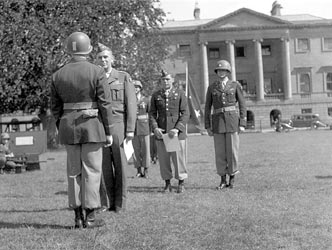

Above
left: A post D-Day photograph of an awards ceremony held in the grounds
of Basildon Park.
Above right: After the passage of more than 60 years, Little
has changed.
321st GFA Battalion
Just like the 81st AAA the 321st GFA arrived in England onboard the Samaria. From Liverpool they travelled by train to the small market town of Wantage, where they were met by GMC trucks that took them on the final leg of their journey to Whatcombe Farm. The farm is about 2 miles north of the village of Great Shefford and before the war was a training yard for racehorses. The majority of the 321st's elisted men were accommodated in stables whilst Lt. Col. Edward L Carmichael (the unit's commanding officer) and his staff lived a mile or so north of the farm at South Fawley Manor.

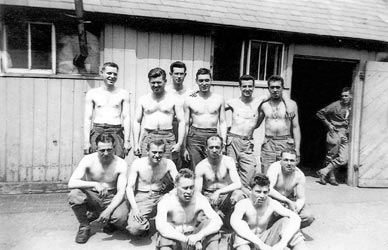
Left:
South Fawley Manor from the air looking north (Gary Dettore)
Right: Men of Battery 'A' near their stables at Whatcombe Farm. Can
anybody help put names to the faces? (Al Lelonek)
John Naseajr was a member of the 321st GFA and remembers the stables at Whatcombe Farm. "'A' Battery shared one line of stables and 'B' Battery the other line of stables. I was in 'B' Battery and four men shared each stall. I had a top bunk - hard wire - on which we laid a matress stuffed with hay".
377th PFA Battalion
On its arrival in England the 377th PFA was initially sent to a camp near Donnington Castle, just north-west of Newbury. However, by Christmas the battalion had moved to the Georgian mansion at Benham Vallence, then home to the Sutton family. It was an impressive place to live with extensive lawns, large lake and magnificent views of the surrounding countryside. The battalion's commanding officer, Lt. Col. Benjamin Weisberg, and his staff lived in the mansion, while the enlisted men were billited in stables and farm buildings nearby.
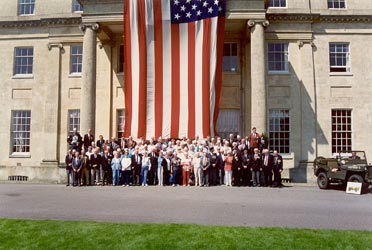
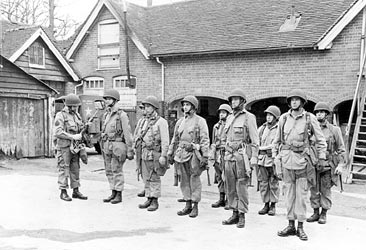
Above
Left: Veterans from the 101st Airborne Division return to Benham Vallence
in 1994 to mark the 50th anniversary of D-Day.
Above right: Personnel from the 377th PFA parade near farm buildings
on the Benham Vallence Estate. Can any reader identify the excact location
of these buildings?
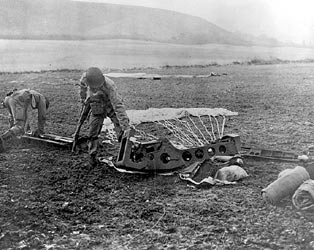
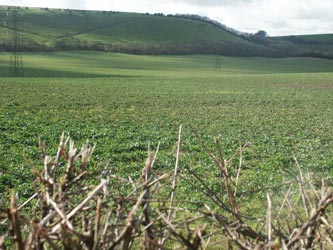
Above
Left: Men from the 377th PFA on exercise just north of Watership Down
close to the Hampshire/Berkshire border.
Above right: A modern day comparison (Tim Green)
907th GFA Battalion
While in England the 907th GFA was accommodated in farm buildings, huts and tents at Bradford's Farm that lies beside the A4 road a mile or so west of the 377th's camp at Benham Vallence. The unit was commanded by Lt. Col. Clarance F Nelson.

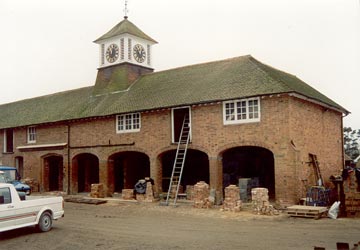
Above
left: Cpl. Howard near tents pitched on farmland just south of the
Hungerford/Newbury road (A4) a few hundred yards east of Bradford's Farm.
Above right: Bradford's Farm pictured about 15 years ago.
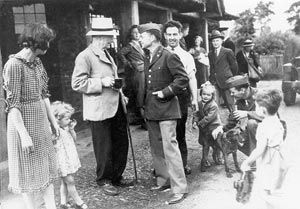
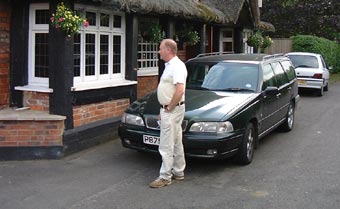
When off duty American servicemen enjoyed patronising English public houses (known colloquially as pubs) which were very different to their bars back home. Situated conveniently between the 377th and 907th camps was a pub called 'The Red House'. The picture on the left was probably taken shortly after American troops arrived in the Newbury area - the picture on the right is a modern day comparison.
My interest
| Aviation Archaeology
| Ramsbury's
Home Front | Ramsbury
Airfield | Savernake
Ammo Dump | Mystery
Corner | 101st
Airborne Division
Membury
airfield | Normandy
- some places of interest |
Links
Page |
Home
Page |
Obituaries
| Recommended
Reading | Aldbourne
Stable Project |
The
Great War
©
Copyright 2014 Roger Day